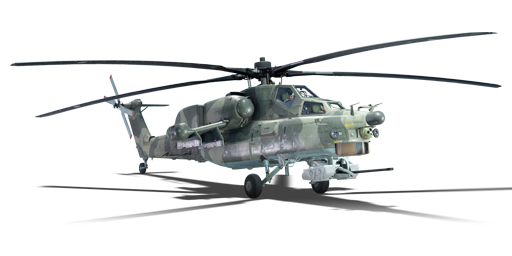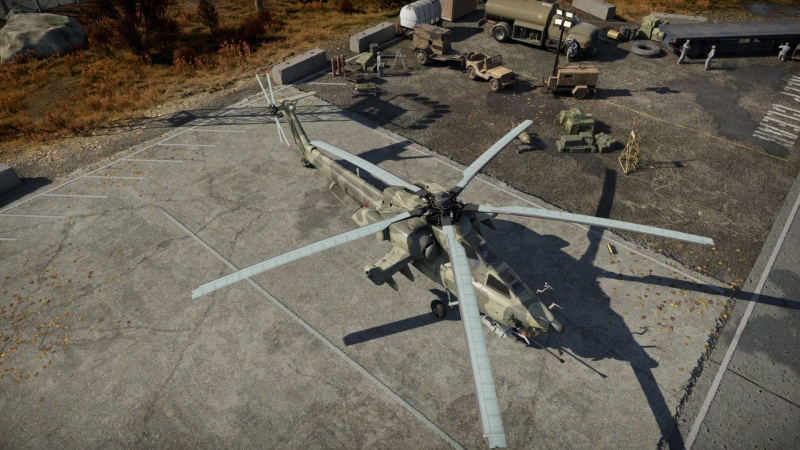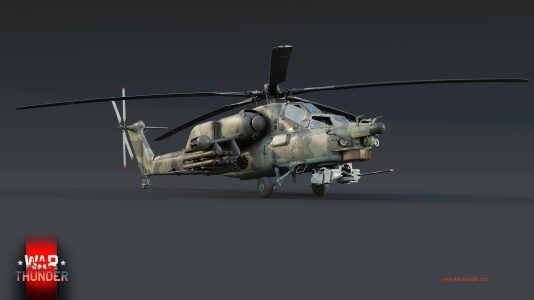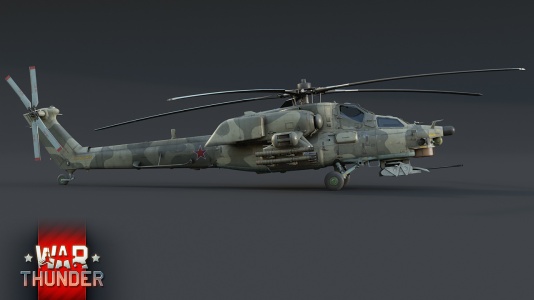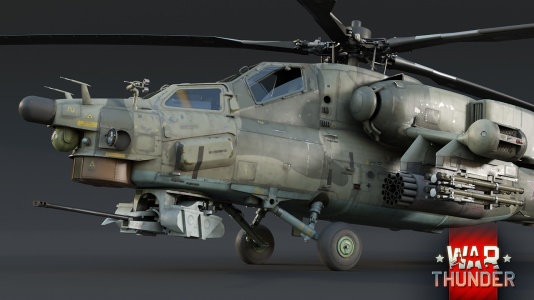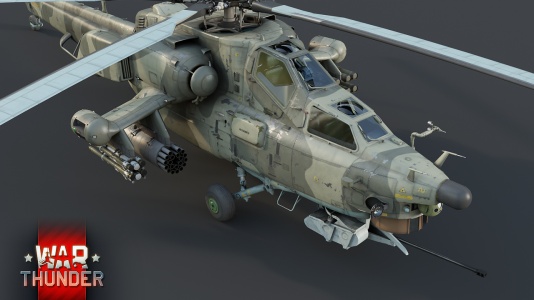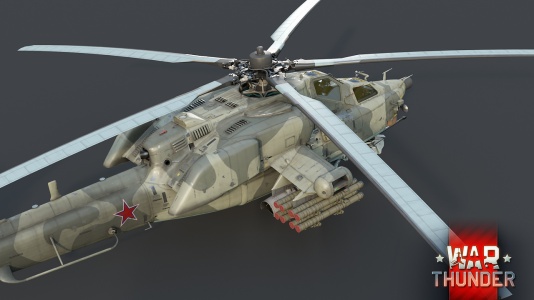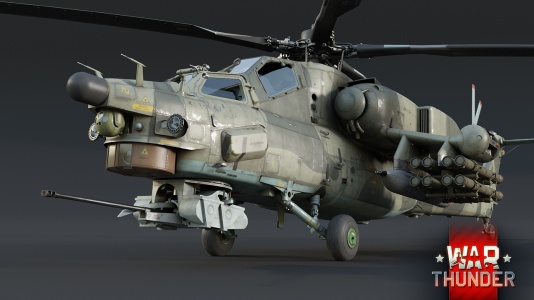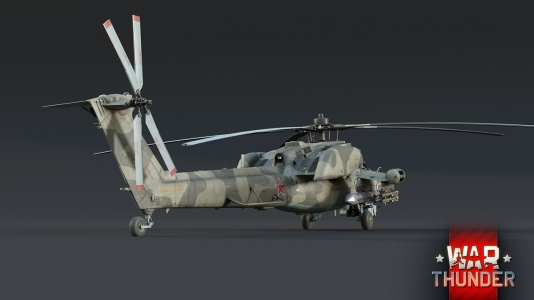Difference between revisions of "Mi-28N"
(Edits) |
(Added About template) |
||
| Line 1: | Line 1: | ||
| + | {{About | ||
| + | | about = Soviet attack helicopter '''{{PAGENAME}}''' | ||
| + | | usage = the other version | ||
| + | | link = Mi-28NM | ||
| + | }} | ||
{{Specs-Card | {{Specs-Card | ||
|code=mi_28n | |code=mi_28n | ||
| Line 136: | Line 141: | ||
;Skins | ;Skins | ||
| − | * [https://live.warthunder.com/feed/camouflages/? | + | * [https://live.warthunder.com/feed/camouflages/?vehicle=mi_28n Skins and camouflages for the {{PAGENAME}} from live.warthunder.com.] |
;Images | ;Images | ||
Revision as of 17:55, 7 November 2021
| This page is about the Soviet attack helicopter Mi-28N. For the other version, see Mi-28NM. |
Contents
Description
The Mi-28N is a rank Soviet attack helicopter with a battle rating of (AB), (RB), and (SB). It was introduced in Update 1.93 "Shark Attack".
General info
Flight performance
| Characteristics | Max Speed (km/h at 1,000 m) |
Max altitude (metres) | |
|---|---|---|---|
| AB | RB | ||
| Stock | 273 | 256 | |
| Upgraded | 324 | 300 | |
Survivability and armour
- Armour plates
- 42 mm Bulletproof glass (52°) - Frontal windshield
- 22 mm Bulletproof glass - Side windows
- 10 mm Aluminium alloy - Cockpit front, middle, rear and bottom
- 10 mm Aluminium alloy - Cockpit sides and doors
- 16 mm Ceramic - Cockpit sides
- 8 mm Steel - Canopy framing
The gunner and the pilot are protected frontally and laterally by bulletproof glass. The front, rear, lower side and bottom of the cockpit are protected by aluminium alloy plates and there is an additional protection plate between the pilot and the gunner. The lower sides of the cockpit are protected by aluminum alloy superposed to ceramic while the canopy cockpit is protected by steel and bulletproof glass.
Modifications and economy
Armaments
| Ballistic Computer | ||
|---|---|---|
| CCIP (Guns) | CCIP (Rockets) | CCIP (Bombs) |
| |
|
|
Offensive armament
The Mi-28N is armed with:
- A choice between two presets:
- 1 x 30 mm 2A42 cannon, chin turret (250 rpg)
- 1 x 30 mm 2A42 cannon, chin turret (250 rpg) + 128 x countermeasures
Suspended armament
The Mi-28N can be outfitted with the following ordnance:
- Without load
- 80 x S-8KO rockets
- 20 x S-13OF rockets
- 8 x 9M120-1 Ataka missiles
- 8 x 9M120-1 Ataka missiles + 40 x S-8KO rockets
- 8 x 9M120-1 Ataka missiles + 10 x S-13OF rockets
- 16 x 9M120-1 Ataka missiles
- 16 x 9M120-1 Ataka missiles + 40 x S-8KO rockets
- 16 x 9M120-1 Ataka missiles + 10 x S-13OF rockets
- 8 x 9M39 Igla missiles
- 8 x 9M39 Igla missiles + 40 x S-8KO rockets
- 8 x 9M39 Igla missiles + 10 x S-13OF rockets
- 2 x 23 mm GSh-23L cannons (250 rpg = 500 total)
- 2 x 23 mm GSh-23L cannons + 40 x S-8KO rockets
- 2 x 23 mm GSh-23L cannons + 10 x S-13OF rockets
- 2 x 23 mm GSh-23L cannons + 8 x 9M120-1 Ataka missiles
- 2 x 23 mm GSh-23L cannons + 16 x 9M120-1 Ataka missiles
- 2 x 23 mm GSh-23L cannons + 8 x 9M39 Igla missiles
- 4 x 9M39 Igla missiles + 8 x 9M120-1 Ataka missiles + 40 x S-8KO rockets
- 4 x 9M39 Igla missiles + 8 x 9M120-1 Ataka missiles + 2 x 23 mm GSh-23L cannons
- 4 x 9M39 Igla missiles + 8 x 9M120-1 Ataka missiles + 10 x S-13OF rockets
Usage in battles
Describe the tactics of playing in a helicopter, the features of using the helicopter in a team and advice on tactics. Refrain from creating a "guide" - do not impose a single point of view, but instead, give the reader food for thought. Examine the most dangerous enemies and give recommendations on fighting them. If necessary, note the specifics of the game in different modes (AB, RB, SB).
Pros and cons
Pros:
- Heavily armed attack helicopter:
- Can carry up to 16 Ataka ATGM penetrating up to 950 mm of armor.
- Can equip up to 8 Igla air-to-air missiles which can't be deflected by flares (ECCM).
- Can be fitted with powerful anti-tank S-13DF rockets.
- Very effective cannon that can shoot APDS rounds.
- Fast helicopter.
- Enhanced survivability:
- Is fitted with flares (up to 128 flares)
- Has thermal vision optics
- Is equipped with missile approach warning system.
Cons:
- Really heavy helicopter, this impacts its manoeuvrability.
- Only 250 rounds for the main gun.
- Igla AAM only have 10G of maximum overload wich is not enough to engage jet fighters.
- Huge helicopter meaning it's a big target.
- Missing a radar.
History
Following the introduction into service of the Mil Mi-24 Hind, design work began on an optimised attack helicopter with reduced secondary transport capacities, intended for a primary anti-armour and anti-helicopter role as well as providing aerial cover for helicopter landings. Following a number of proposed concepts, a preliminary design was chosen in 1977. Following the construction of a mock-up, a prototype was constructed and first flew on November 10th 1982, with a second prototype completed in 1983. Trials of the Mi-28 began in 1984, but the type lost out to the Kamov Ka-50. Despite this, lower priority development of the Mi-28 continued and production of the Mi-28 was approved in December of 1987. In January of 1988, the first prototype Mi-28A flew, fitted with more powerful engines and a different model of tail rotor; this prototype was first shown to the Western world at the 1989 Paris Air Show. In 1991 a second prototype of the Mi-28A flew, but with the end of the Cold War, the end of the Soviet Union and ensuing cuts in the Defence budget, the Mi-28A was re-evaluated and found superior to the Ka-50, especially due to it lacking all-weather capabilities. As such, the Ka-50A was cancelled in 1993.
The Mi-28N was first presented in 1995 and first flew on November 14th 1996. Unlike the preceding Mi-28A, the Mi-28N was fitted with a whole array of vision aids, such as radar, a gun camera and forward-looking infrared (FLIR), giving it an all-weather capability. Once again, the post-Cold War realities in the Russian Federation meant that funds were not available and the program was given a low priority.
This changed in 2000 when attention was given to re-equipping the Russian Army. The Mi-28N was given a new priority, as a future replacement of the Mi-24. In 2004, a second prototype with an altered main rotor design was flown, and after trials, the first production Mi-28N was accepted by the Russian military on June 5th 2006, with the type being declared operational in October 2009. An export model, the Mi-28NE, has since been sold to both Iraq and Algeria. An updated model, the Mi-28NM, was first flown in 2016, with the first production examples delivered to the Russian military in June of 2019.
Media
- Skins
- Images
- Videos
See also
Links to the articles on the War Thunder Wiki that you think will be useful for the reader, for example:
- reference to the series of the helicopter;
- links to approximate analogues of other nations and research trees.
External links
| Mil Moscow Helicopter Plant | |
|---|---|
| Attack | Mi-4AV |
| Mi-8AMTSh · Mi-8AMTSh-VN · Mi-8TV | |
| Mi-24A · Mi-24P · Mi-24V | |
| Mi-28N · Mi-28NM | |
| Mi-35M | |
| Export | ◊Mi-8TB |
| ▂Mi-24D · ◔Mi-24D · ◔Mi-24V · ◔Mi-24P · ◊Mi-24P · ◄Mi-24P HFS 80 · Superhind | |
| Mi-28A | |
| ▄Mi-35M | |
| USSR helicopters | |
|---|---|
| Attack | |
| Hound | Mi-4AV |
| Hip | Mi-8AMTSh · Mi-8AMTSh-VN · Mi-8TV |
| Hind | Mi-24A · ▂Mi-24D · Mi-24P · Mi-24V · Mi-35M |
| Havoc | Mi-28N · Mi-28NM |
| Helix | Ka-29 |
| Hokum | Ka-50 · Ka-52 |


